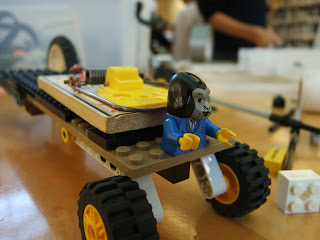 While we only had two classes this week, a lot of progress was made. We moved from our iteration phase, where we brainstormed ideas about how we might solve the problem that we defined in our definition phase, to prototyping. This is where the fun, for most of the boys, began. They got to get their hands dirty and try out some of the ideas that they'd thought up during previous phases of the design process.
While we only had two classes this week, a lot of progress was made. We moved from our iteration phase, where we brainstormed ideas about how we might solve the problem that we defined in our definition phase, to prototyping. This is where the fun, for most of the boys, began. They got to get their hands dirty and try out some of the ideas that they'd thought up during previous phases of the design process. It was fascinating to watch as they began trying out different concepts, quickly rejecting some and building on others. There were many failures, but each failure seemed to generate some valuable learning that propelled them toward a better solution. It was also very interesting to see how deliberate some groups and individuals were with the process. A thought process might have gone something like:
- We'd originally thought that string would be the best material to use between our mousetrap and wheel.
- I wonder if the elasticity of rubber bands would propel the vehicle further
- Let's try the rubber bands
- That was/was not more effective. Why? Is it the rubber band or is it the way we are using it?
- Is the connection between the ideation phase and the prototyping phase strong?
Are the boys actually taking an idea that they had during the ideation phase and prototyping it? Or are they starting somewhat fresh in the prototyping phase? - Are the groups being purposeful with their materials?
Only one group brought in their own materials. The others went to the prototyping kit (a couple of tubs filled with materials that might be used for prototyping) and used whatever they could find. These designs ended up changing to suite the materials available to them. I'm unsure how much of an effort was made to stick to the original idea and find materials that suited the design. - The group dynamics were distinctly different between groups.
Some groups functioned well as a unit while others made the decision early to separate into smaller entities from the beginning (pairs or individuals). Still others seemed to have leaders who did much of the work while others observed and commented.

Next week will give them an opportunity to finish their vehicles and test them. This will take two of their four classes. We will be trying out an app from Vernier to take video of the actual test runs and analyze their results. This will carry over into the Math and Science classes where they can look at the results and make observations that will inform the students understanding of how the vehicles performed from a physics standpoint and give them some information to help them with their next iteration of the vehicle. As we've not used this tool before, we are testing it as much as we are testing the vehicles at this point.

Finally, we will be tearing apart the process in order to understand how we can use the design thinking model better the next time around. We will also make sure that we look at the products themselves to see what kinds of design improvements we need to make as well as investigating how effective our group dynamic was in tackling the problem. Expect lengthy posts in the come week from the boys!











